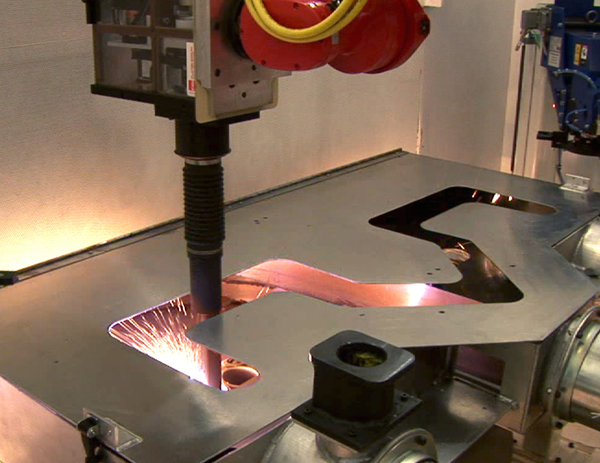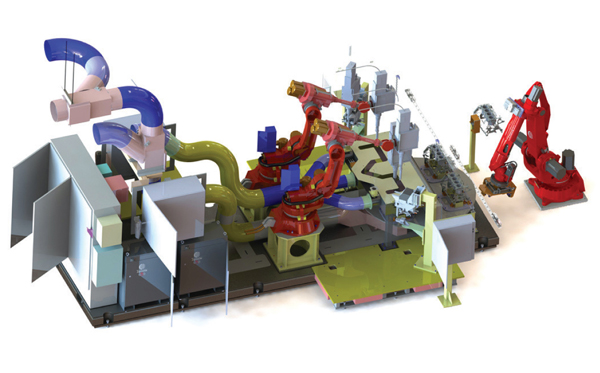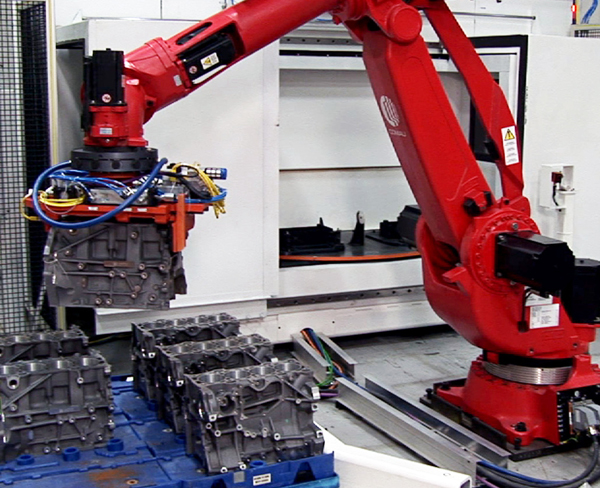
Thermal spray coated liners offer an alternative to cast iron liners in aluminium blocks
 One of many challenges for today’s automotive manufacturers is reducing vehicle weight and frictional losses in the powertrain as a means of improving overall vehicle efficiency. This has been a driving force in the adoption of aluminum alloy engine blocks as an alternative to traditional cast iron blocks. The primary advantage of aluminum includes lower overall weight. Cast iron liners were still used, however, because they possess important tribological characteristics that common aluminum alloys do not have. As such, many vehicle-makers have spent significant time engineering solutions that are capable of addressing the tribological deficiencies associated with aluminum cylinder blocks.
One of many challenges for today’s automotive manufacturers is reducing vehicle weight and frictional losses in the powertrain as a means of improving overall vehicle efficiency. This has been a driving force in the adoption of aluminum alloy engine blocks as an alternative to traditional cast iron blocks. The primary advantage of aluminum includes lower overall weight. Cast iron liners were still used, however, because they possess important tribological characteristics that common aluminum alloys do not have. As such, many vehicle-makers have spent significant time engineering solutions that are capable of addressing the tribological deficiencies associated with aluminum cylinder blocks.
One of the early solutions was to use cast iron sleeves in the cylinder bores of aluminum blocks. This solution was easy to conceptualise from a manufacturing standpoint and relatively inexpensive as compared to alternative bore solutions such as Nikasil, Lokasil and others that were available at the time. The disadvantages with gray cast iron liners (GCI) are the packaging of the liner into the block and the weight. A significant disadvantage of a GCI liner is its thermodynamic properties as compared to the aluminum. It is not only the thermal conductivity that is an issue but also the thermal capacitance, which hampers the ability to maintain efficient piston and bore temperatures for optimal combustion. This may be further hindered, depending on the insertion type, if the lay-up of the liner to the block material is not ideal and creates insulation points between the liner and block. Depending on the location of these regions of poor lay-up there can be significant changes to the knock resistance of the production engine.
The development of thermal spray internal bore application technologies now enables automotive manufacturers to apply a wear resistant coating on the cylinder bores as an alternative to cast iron sleeves. Comau is offering this with an integrated, innovative Plasma Transferred Wire Arc (PTWA) thermal spraying system. PTWA process enables the coating of aluminum cylinder bores with a fine spray of molten steel particles at a high speed. Effectively, the coated aluminum block becomes a monolithic mass that does not suffer the bore distortion issues that are created by having a cast-in GCI liner, nor does it have the poor thermodynamics of such a GCI block. The replacement of the GCI liner with the PTWA coated bore not only reduces the final weight of the engine, but also increases its endurance and lowers its energy consumption.
Benefits of thermal spray coated liners
It has been consistently reported that thermal spray coated liners offer considerable advantages over cast iron liners. In terms of weight, they can deliver a reduction of up to 0.5kg per bore depending on the geometry of the block, as well as improved durability. They also facilitate manufacturing flexibility, as a single piece of equipment can coat different size bores both in terms of length and diameter. More importantly, thermal spray coating improves: thermodynamics, heat dissipation, mechanical efficiency and is an enabler for improved overall fuel efficiency.
 Process configuration
Process configuration
The key to a successful implementation of a thermal spray coating solution starts with the process configuration. Implementation within a greenfield site provides obvious advantages in terms of flexibility and optimal integration, whereas an existing (brownfield) manufacturing operation may have limitations in terms of where in the process the spray coating will be placed.
If a manufacturer is looking to minimise the need for new equipment in a brownfield site and wants to add only the thermal spray unit, for example, a common thought is to place it as far up stream as possible, but this strategy has significant impact on investment and engine performance. Vehicle-makers will, therefore, need to carefully balance their manufacturing goals, prioritising the relative importance of simplicity, engine performance and overall investments when selecting the best solution. Clearly the 'best' solution is one designed to optimise the manufacturing priorities and seamlessly integrate within the existing processes. Although there are multiple options available, the solution that Comau currently recommends is one that integrates fine boring with surface preparation, coating, and then a rough hone bore finish.
Surface preparation
Preparing the substrate surface (the uncoated bore wall) is a first critical step in the successful application of thermal spray coating. There are a number of surface preparation techniques with notable differences in terms of bond strength, ease of application and cost; the most common of which are grit blast, water jet and mechanical roughening.
While early adopter engine manufacturers used grit blast, Comau feels there are too many inherent issues to take it into consideration. The most notable of these is that grit blast requires aggressive cleaning and drying. While many automotive companies avoid grit blasting because of contamination issues in the engine, from a thermal spray coating viewpoint the presence of even the smallest grit fines generated during this process will negatively impact the adhesion of the sprayed coating.
High-pressure water jet roughening, by comparison, uses fluid stream dynamics to erode the substrate without the use of grit or roughening materials. The advantage of this method is that the roughened surface only requires drying, not cleaning.
If opting for a water-based roughening solution, it is critical to evaluate the substrate quality and porosity, particularly HPDC. The process will change the bore diameter significantly and as such, monitoring and robust controls are needed to maintain control and consistency. The surface complexity generated is one of the most complex and robust for coating adhesion, however, the difficulty in measuring the surface for SPC makes it hard to monitor on the work piece.
Once these factors have been understood and accounted for, the process tends to be fairly stable and provides good repeatability. Additionally, the relatively low level of resulting surface macro-roughness, which is in the order of tens of microns, means that you have a relatively smooth substrate surface that benefits the coating process by reducing the as-sprayed coating roughness. The issue that may arise with this process, especially when coupled with HPD castings, which can inherently have some shrinkage, is that the process will actually exacerbate defects including the deepening of existing porosity or shrinkage. This interaction with the casting flaw may cause it to become large enough to cause a non-clean-up condition or may create instances of bridging.
Mechanical roughening
An alternative to grit blasting and water jet is a mechanical surface fine bore machining (mechanical roughening). Depending on the tool technology used, the roughening can be accomplished by: cutting and breaking the surface, cutting and forging the threaded form to create a deformed square groove, or by producing concentric grooves with interrupted forging.
Another option is simple threaded form to create the direct cutting of a surface with a dovetail cut that is easy to monitor when you have the correct equipment. First introduced in theory as early as 1943, the advantages of mechanical roughening compared to grit blast are the absence of contaminants and the reproducibility. A key advantage over water jet is its ability to easily handle the changes in porosity and casting integrity, as it provides the ability to handle a porosity of up to 1.25mm depending on which type is used. Mechanical roughening is stable, easily implemented and because it is based on a mechanical cutting process, quality control and measuring is fairly straightforward.
 Comau feels that one of the biggest advantages to mechanical roughening is the ability to perform the machining as a dry or minimal quantity lubrication (MQL) process. In this manner the manufacturer is able to go directly from the bore-finishing straight to the coating process. This eliminates one full step in the production line, saving time and streamlining the overall system. The other advantage is consistently high bond strength. It should be kept in mind that consistent bond strength is required for all engine bore applications. Depending on the manufacturing parameters, bond strength has historically been from 35 – 50MPa, although anything above 20MPa is sufficient. By adopting mechanical roughening in a standard boring machine or machining centre, manufacturers can generate a robust surface preparation with the lowest processing and investment costs.
Comau feels that one of the biggest advantages to mechanical roughening is the ability to perform the machining as a dry or minimal quantity lubrication (MQL) process. In this manner the manufacturer is able to go directly from the bore-finishing straight to the coating process. This eliminates one full step in the production line, saving time and streamlining the overall system. The other advantage is consistently high bond strength. It should be kept in mind that consistent bond strength is required for all engine bore applications. Depending on the manufacturing parameters, bond strength has historically been from 35 – 50MPa, although anything above 20MPa is sufficient. By adopting mechanical roughening in a standard boring machine or machining centre, manufacturers can generate a robust surface preparation with the lowest processing and investment costs.
Current mechanical roughening standards call for a minimum groove depth of around 0.125mm to achieve a minimally acceptable level of bond strength. Comau has found through its own testing that mechanically cut grooves with a depth that is greater than the width (depth/width >1) produce a sufficient bond strength and by plastically deforming the grooves enough to create an under-cut, adhesion significantly increases. The company has, as a result, retooled its Urane25 high-speed horizontal machining centre to deliver a dual-channel MQL mixing unit with integrated temperature monitoring and energy-saving features to help vehicle-makers more easily deploy high-performing yet economical thermal spray coating with optimised bond adhesion, while reducing overall energy and emulsions consumption. Several vehicle-makers and tooling companies have developed different mechanical roughening process technologies in an attempt to minimise bore coating implementation into an existing operational line. [sam_ad id=17 codes='true']
In addition to the technology itself, there are also multiple block design elements to take into consideration, including opportunities to improve or eliminate masking, to optimise the geometry of the block design for coating, and the overall thickness of bore coating. A detailed examination of these underlying technologies, can be viewed in the Comau Thermal Spray webinar hosted by AMS.
The latest in engine design paradigm is thermal spray coated cylinder bores; whether designing a new line or retrofitting an existing one, it is an essential solution for advanced light alloy engine production. Here at Comau, we combine global design and integration expertise in automation, machining, coating and test systems to help our clients to find optimal solutions for their facilities and manufacturing strategies. No matter what the operating environment, Comau is dedicated to helping increase productivity and ensure greater throughput, which are two key success factors in today’s increasingly competitive global marketplace.
Powertrain Systems is business unit of Comau, and is a full service solutions provider with over 40 years of experience in the market. Its vast portfolio of modular machines and expertise in the machining process make Comau a worldwide leader in developing flexible solutions that can efficiently boost the performance of production facilities. By integrating cutting-edge technologies, such as PTWA, Comau is able to combine innovative capabilities in machining, assembly and automation to deliver complete, turn-key solutions for the entire production line.
Headquartered in Italy, with an international network that spans 15 countries, Comau uses the latest technology and processes to deliver advanced turnkey systems that consistently exceed the expectations of its customers. Comau specializes in body welding & assembly, powertrain machining & assembly, robotics and maintenance as well as environmental services for a wide range of industrial sectors. The continuous expansion and improvement of its product range enables Comau to guarantee customized assistance at all phases of a project – from design, implementation and installation, to production start-up and maintenance services.
For further information about Comau’s consolidated experience and its vast portfolio of products and services, visit www.comau.com.



































